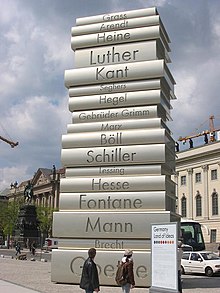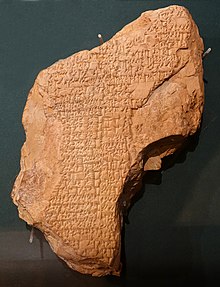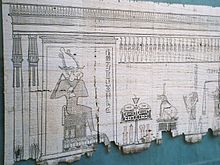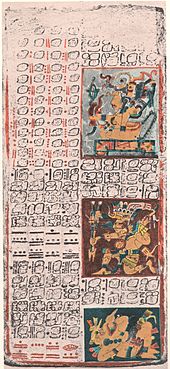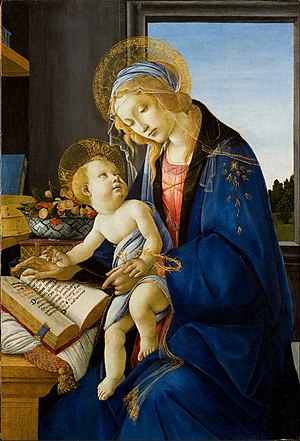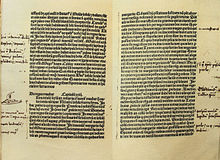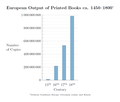Birthday Book Printing, the fourth of the six Walk of Ideas sculptures displayed in Berlin during 2006, represents a pile of modern codex books.
The history of books starts with the development of writing, and various other inventions such as paper and printing, and continues through to the modern day business of book printing.
The earliest history of books actually predates what would
conventionally be called "books" today and begins with tablets, scrolls,
and sheets of papyrus. Then hand-bound, expensive, and elaborate books known as codices appeared. These gave way to press-printed
volumes and eventually lead to the mass printed tomes prevalent today.
Contemporary books may even have no physical presence with the advent of
the e-book. The book also became more accessible to the disabled with the advent of Braille and spoken books.
Clay tablets
Sumerian clay tablet, currently housed in the Oriental Institute at the University of Chicago, inscribed with the text of the poem Inanna and Ebih by the priestess Enheduanna, the first author whose name is known
Clay tablets were used in Mesopotamia
in the 3rd millennium BC. The calamus, an instrument in the form of a
triangle, was used to make characters in moist clay. People used to use
fire to dry the tablets out. At Nineveh, over 20,000 tablets were found, dating from the 7th century BC; this was the archive and library of the kings of Assyria,
who had workshops of copyists and conservationists at their disposal.
This presupposes a degree of organization with respect to books,
consideration given to conservation, classification, etc. Tablets were
used right up until the 19th century in various parts of the world,
including Germany, Chile, Philippines and the Saharan Desert.
Cuneiform and Sumerian Writing
Writing originated as a form of record keeping in Sumer during the fourth millennium BCE with the advent of cuneiform.
Many clay tablets have been found that show cuneiform writing used to
record legal contracts, create lists of assets, and eventually to record
Sumerian literature and myths. Scribal schools have been found by
archaeologists from as early as the second millennium BCE where students
were taught the art of writing.
Papyrus
Egyptian Papyrus
After extracting the marrow from the stems of Papyrus reed, a
series of steps (humidification, pressing, drying, gluing, and cutting)
produced media of variable quality, the best being used for sacred
writing. In Ancient Egypt, papyrus was used as a medium for writing surfaces, maybe as early as from First Dynasty, but first evidence is from the account books of King Neferirkare Kakai of the Fifth Dynasty (about 2400 BC). A calamus, the stem of a reed sharpened to a point, or bird feathers were used for writing. The script of Egyptian scribes was called hieratic, or sacerdotal writing; it is not hieroglyphic,
but a simplified form more adapted to manuscript writing (hieroglyphs
usually being engraved or painted). Egyptians exported papyrus to other
Mediterranean civilizations including Greece and Rome where it was used
until parchment was developed.
Papyrus books were in the form of a scroll of several sheets pasted together, for a total length of 10 meters or more. Some books, such as the history of the reign of Ramses III,
were over 40 meters long. Books rolled out horizontally; the text
occupied one side, and was divided into columns. The title was indicated
by a label attached to the cylinder containing the book. Many papyrus
texts come from tombs, where prayers and sacred texts were deposited
(such as the Book of the Dead, from the early 2nd millennium BC).
East Asia
A Chinese bamboo book
Before the introduction of books, writing on bone, shells, wood and silk was prevalent in China long before the 2nd century BC, until paper
was invented in China around the 1st century AD. China's first
recognizable books, called jiance or jiandu, were made of rolls of thin
split and dried bamboo bound together with hemp, silk, or leather. The discovery of the process using the bark of the blackberry bush to create paper is attributed to Ts'ai Lun (the cousin of Kar-Shun), but it may be older. Texts were reproduced by woodblock printing;
the diffusion of Buddhist texts was a main impetus to large-scale
production. The format of the book evolved with intermediate stages of
scrolls folded concertina-style, scrolls bound at one edge ("butterfly books") and so on.
Although there is no exact date known, between 618 and 907 AD–The
period of the Tang Dynasty–the first printing of books started in
China. The oldest extant printed book is a work of the Diamond Sutra and dates back to 868 AD, during the Tang Dynasty. The Diamond Sutra was printed by method of woodblock printing,
a strenuous method in which the text to be printed would be carved into
a woodblock's surface, essentially to be used to stamp the words onto
the writing surface medium.
Woodblock printing was a common process for the reproduction of already
handwritten texts during the earliest stages of book printing. This
process was incredibly time-consuming.
Because of the meticulous and time-consuming process that woodblock printing was, Bi Sheng, a key contributor to the history of printing, invented the process of movable type printing (1041-1048 AD).
Bi Sheng developed a printing process in which written text could be
copied with the use of formed character types, the earliest types being
made of ceramic or clay material. The method of movable type printing would later become improved by Johannes Gutenberg.
Pre-columbian codices of the Americas
Dresden Codex (page 49)
In Mesoamerica, information was recorded on long strips of paper,
agave fibers, or animal hides, which were then folded and protected by
wooden covers. These were thought to have existed since the time of the
Classical Period between the 3rd and 8th centuries, CE. Many of these
codices were thought to contain astrological information, religious
calendars, knowledge about the gods, genealogies of the rulers,
cartographic information, and tribute collection. Many of these codices
were stored in temples but were ultimately destroyed by the Spanish
explorers.
Currently, the only completely deciphered pre-Columbian writing system is the Maya script. The Maya, along with several other cultures in Mesoamerica, constructed concertina-style books written on Amate paper. Nearly all Mayan texts were destroyed by the Spanish during colonization on cultural and religious grounds. One of the few surviving examples is the Dresden Codex.
Although only the Maya have been shown to have a writing system
capable of conveying any concept that can be conveyed via speech (at
about the same level as the modern Japanese writing system), other Mesoamerican cultures had more rudimentary ideographical writing systems which were contained in similar concertina-style books, one such example being the Aztec codices.
Florentine Codex
There
are more than 2,000 illustrations drawn by native artists that
represent this era. Bernardino de Sahagun tells the story of Aztec
people’s lives and their natural history. The Florentine Codex speaks
about the culture religious cosmology and ritual practices, society,
economics, and natural history of the Aztec people. The manuscript are
arranged in both the Nahuatl language and in Spanish. The English
translation of the complete Nahuatl text of all twelve volumes of the
Florentine Codex took ten years. Arthur J.O. Anderson and Charles Dibble
had a decade of long work but made it an important contribution to
Mesoamerican ethnohistory. Years later, in 1979, the Mexican government
published a full-color volume of the Florentine Codex. Now, since 2012,
it is available digitally and fully accessible to those interested in
Mexican and Aztec History.
The Florentine Codex is a 16th century ethnographic research
study brought about by the Spanish Franciscan friar Bernardino de
Sahagun. The codex itself was actually named La Historia Universal de las Cosas de Nueva España.
Bernardino de Sahagun worked on this project from 1545 up until his
death in 1590. The Florentine Codex consist of twelve books. It is 2400
pages long but divided into the twelve books by categories such as; The
Gods, Ceremonies, Omens, and other cultural aspects of Aztec people.
Wax tablets
Romans used wax-coated wooden tablets or pugillares upon which they could write and erase by using a stylus.
One end of the stylus was pointed, and the other was spherical. Usually
these tablets were used for everyday purposes (accounting, notes) and
for teaching writing to children, according to the methods discussed by Quintilian in his Institutio Oratoria X Chapter 3. Several of these tablets could be assembled in a form similar to a codex. Also the etymology of the word codex (block of wood) suggest that it may have developed from wooden wax tablets.
Parchment
Parchment progressively replaced papyrus. Legend attributes its invention to Eumenes II, the king of Pergamon,
from which comes the name "pergamineum," which became "parchment." Its
production began around the 3rd century BC. Made using the skins of
animals (sheep, cattle, donkey, antelope, etc.), parchment proved to be
easier to conserve over time; it was more solid, and allowed one to
erase text. It was a very expensive medium because of the rarity of
material and the time required to produce a document. Vellum is the finest quality of parchment.
Greece and Rome
The scroll of papyrus
is called "volumen" in Latin, a word which signifies "circular
movement," "roll," "spiral," "whirlpool," "revolution" (similar,
perhaps, to the modern English interpretation of "swirl") and finally "a
roll of writing paper, a rolled manuscript, or a book."
In the 7th century Isidore of Seville explains the relation between codex, book and scroll in his Etymologiae (VI.13) as this:
| “ | A codex is composed of many books (librorum); a book is of one scroll (voluminis). It is called codex by way of metaphor from the trunks (caudex) of trees or vines, as if it were a wooden stock, because it contains in itself a multitude of books, as it were of branches. | ” |
Description
The
scroll is rolled around two vertical wooden axes. This design allows
only sequential usage; one is obliged to read the text in the order in
which it is written, and it is impossible to place a marker in order to
directly access a precise point in the text. It is comparable to modern
video cassettes. Moreover, the reader must use both hands to hold on
to the vertical wooden rolls and therefore cannot read and write at the
same time. The only volumen in common usage today is the Jewish Torah.
Book culture
The authors of Antiquity
had no rights concerning their published works; there were neither
authors' nor publishing rights. Anyone could have a text recopied, and
even alter its contents. Scribes earned money and authors earned mostly
glory, unless a patron provided cash; a book made its author famous.
This followed the traditional conception of the culture: an author stuck
to several models, which he imitated and attempted to improve. The
status of the author was not regarded as absolutely personal.
From a political and religious point of view, books were censored very early: the works of Protagoras were burned because he was a proponent of agnosticism
and argued that one could not know whether or not the gods existed.
Generally, cultural conflicts led to important periods of book
destruction: in 303, the emperor Diocletian ordered the burning of Christian texts. Some Christians
later burned libraries, and especially heretical or non-canonical
Christian texts. These practices are found throughout human history but
have ended in many nations today. A few nations today still greatly
censor and even burn books.
But there also exists a less visible but nonetheless effective
form of censorship when books are reserved for the elite; the book was
not originally a medium for expressive liberty. It may serve to confirm
the values of a political system, as during the reign of the emperor Augustus,
who skillfully surrounded himself with great authors. This is a good
ancient example of the control of the media by a political power.
However, private and public censorship have continued into the modern
era, albeit in various forms.
Proliferation and conservation of books in Greece
Little information concerning books in Ancient Greece
survives. Several vases (6th and 5th centuries BC) bear images of
volumina. There was undoubtedly no extensive trade in books, but there
existed several sites devoted to the sale of books.
The spread of books, and attention to their cataloging and conservation, as well as literary criticism developed during the Hellenistic period with the creation of large libraries in response to the desire for knowledge exemplified by Aristotle. These libraries were undoubtedly also built as demonstrations of political prestige:
- The Library of Alexandria, a library created by Ptolemy Soter and set up by Demetrius Phalereus (Demetrius of Phaleron). It contained 500,900 volumes (in the Museion section) and 40,000 at the Serapis temple (Serapeion). All books in the luggage of visitors to Egypt were inspected, and could be held for copying. The Museion was partially destroyed in 47 BC.
- The Library at Pergamon, founded by Attalus I; it contained 200,000 volumes which were moved to the Serapeion by Mark Antony and Cleopatra, after the destruction of the Museion. The Serapeion was partially destroyed in 391, and the last books disappeared in 641 CE following the Arab conquest.
- The Library at Athens, the Ptolemaion, which gained importance following the destruction of the Library at Alexandria ; the Library of Pantainos, around 100 CE; the library of Hadrian, in 132 CE.
- The Library at Rhodes, a library that rivaled the Library of Alexandria.
- The Library at Antioch, a public library of which Euphorion of Chalcis was the director near the end of the 3rd century.
The libraries had copyist workshops, and the general organization of books allowed for the following:
- Conservation of an example of each text
- Translation (the Septuagint Bible, for example)
- Literary criticisms in order to establish reference texts for the copy (example : The Iliad and The Odyssey)
- A catalog of books
- The copy itself, which allowed books to be disseminated
Book production in Rome
Book production developed in Rome
in the 1st century BC with Latin literature that had been influenced by
the Greek. Conservative estimates places the number of potential
readers in Imperial Rome at around 100,000 people.
This diffusion primarily concerned circles of literary individuals. Atticus was the editor of his friend Cicero. However, the book business progressively extended itself through the Roman Empire; for example, there were bookstores in Lyon. The spread of the book was aided by the extension of the Empire, which implied the imposition of the Latin tongue on a great number of people (in Spain, Africa, etc.).
Libraries were private or created at the behest of an individual. Julius Caesar, for example, wanted to establish one in Rome, proving that libraries were signs of political prestige.
In the year 377, there were 28 libraries in Rome, and it is known
that there were many smaller libraries in other cities. Despite the
great distribution of books, scientists do not have a complete picture
as to the literary scene in antiquity as thousands of books have been
lost through time.
Paper
Papermaking has traditionally been traced to China about AD 105, when Cai Lun, an official attached to the Imperial court during the Han Dynasty (202 BC – 220 AD), created a sheet of paper using mulberry and other bast fibres along with fishnets, old rags, and hemp waste.
While paper used for wrapping and padding was used in China since the 2nd century BC, paper used as a writing medium only became widespread by the 3rd century. By the 6th century in China, sheets of paper were beginning to be used for toilet paper as well. During the Tang Dynasty (618–907 AD) paper was folded and sewn into square bags to preserve the flavor of tea. The Song Dynasty (960–1279) that followed was the first government to issue paper currency.
An important development was the mechanization of paper manufacture by medieval papermakers. The introduction of water-powered paper mills, the first certain evidence of which dates to the 11th century in Córdoba, Spain, allowed for a massive expansion of production and replaced the laborious handcraft characteristic of both Chinese and Muslim
papermaking. Papermaking centres began to multiply in the late 13th
century in Italy, reducing the price of paper to one sixth of parchment and then falling further.
Middle Ages
The codex Manesse, a book from the Middle Ages
By the end of antiquity, between the 2nd and 4th centuries, the scroll was replaced by the codex.
The book was no longer a continuous roll, but a collection of sheets
attached at the back. It became possible to access a precise point in
the text quickly. The codex is equally easy to rest on a table, which
permits the reader to take notes while he or she is reading. The codex
form improved with the separation of words, capital letters, and
punctuation, which permitted silent reading. Tables of contents and
indices facilitated direct access to information. This form was so
effective that it is still the standard book form, over 1500 years after
its appearance.
Paper would progressively replace parchment. Cheaper to produce, it allowed a greater diffusion of books.
Books in monasteries
A number of Christian books were destroyed at the order of Diocletian
in 304 AD. During the turbulent periods of the invasions, it was the
monasteries that conserved religious texts and certain works of Antiquity for the West. But there would also be important copying centers in Byzantium.
The role of monasteries in the conservation of books is not without some ambiguity:
- Reading was an important activity in the lives of monks, which can be divided into prayer, intellectual work, and manual labor (in the Benedictine order, for example). It was therefore necessary to make copies of certain works. Accordingly, there existed scriptoria (the plural of scriptorium) in many monasteries, where monks copied and decorated manuscripts that had been preserved.
- However, the conservation of books was not exclusively in order to preserve ancient culture; it was especially relevant to understanding religious texts with the aid of ancient knowledge. Some works were never recopied, having been judged too dangerous for the monks. Moreover, in need of blank media, the monks scraped off manuscripts, thereby destroying ancient works. The transmission of knowledge was centered primarily on sacred texts.
Copying and conserving books
An author portrait of Jean Miélot writing his compilation of the Miracles of Our Lady, one of his many popular works.
Despite this ambiguity, monasteries in the West and the Eastern
Empire permitted the conservation of a certain number of secular texts,
and several libraries were created: for example, Cassiodorus ('Vivarum' in Calabria, around 550), or Constantine I in Constantinople.
There were several libraries, but the survival of books often depended
on political battles and ideologies, which sometimes entailed massive
destruction of books or difficulties in production (for example, the
distribution of books during the Iconoclasm between 730 and 842). A long list of very old and surviving libraries that now form part of the Vatican Archives can be found in the Catholic Encyclopedia.
A very strong example of the early copying and conserving books is that of the Quran.
After Muhammad, his companion Abu Bakr, on the recommendation of Umar
Bin Alkhattab, assigned Zayd bin Saabit to compile the first official
scripture of the Quran. Zayd collected all the available scriptures of
the Quran scripted by different companions of Muhammad during his life.
He compiled one scripture and got it verified by all the companions who
had memorized the whole book while Muhammad was alive. Then this first
official scripture was kept at the house of Hafsa, the wife of the
Muhammad. By the time of the third caliph Uthmaan, the Islamic state had
spread over a large portion of the known world. He ordered the
preparation of the official copies of the first official scripture. The
copies were duly verified for accuracy. These copies were sent to each
city of the caliphate so that further copies can be made locally with
the perfect accuracy.
To help preserve books and protect them from thieves, librarians would create chained libraries.
Chained Libraries were books displayed next to each other to create a
tight bond. This eliminated unauthorised removal of books. One of the
earliest chained libraries was in England during the 1500s. Popular
culture also has examples of chained libraries, such as in Harry Potter and the Philosopher's Stone by J.K Rowling.
The scriptorium
The
scriptorium was the workroom of monk copyists; here, books were copied,
decorated, rebound, and conserved. The armarius directed the work and
played the role of librarian.
The role of the copyist was multifaceted: for example, thanks to
their work, texts circulated from one monastery to another. Copies also
allowed monks to learn texts and to perfect their religious education.
The relationship with the book thus defined itself according to an
intellectual relationship with God. But if these copies were sometimes made for the monks themselves, there were also copies made on demand.
The task of copying itself had several phases: the preparation of
the manuscript in the form of notebooks once the work was complete, the
presentation of pages, the copying itself, revision, correction of
errors, decoration, and binding. The book therefore required a variety of competencies, which often made a manuscript a collective effort.
Transformation from the literary edition in the 12th century
The scene in Botticelli's Madonna of the Book (1480) reflects the presence of books in the houses of richer people in his time.
The revival of cities in Europe would change the conditions of book
production and extend its influence, and the monastic period of the book
would come to an end. This revival accompanied the intellectual
renaissance of the period. The Manuscript culture
outside of the monastery developed in these university-cities in Europe
in this time. It is around the first universities that new structures
of production developed: reference manuscripts were used by students and
professors for teaching theology
and liberal arts. The development of commerce and of the bourgeoisie
brought with it a demand for specialized and general texts (law,
history, novels, etc.). It is in this period that writing in the common
vernacular developed (courtly poetry, novels, etc.). Commercial
scriptoria became common, and the profession of book seller came into
being, sometimes dealing internationally.
There is also the creation of royal libraries as in the case of Saint Louis and Charles V. Books were also collected in private libraries, which became more common in the 14th and 15th centuries.
The use of paper diffused through Europe in the 14th century. This material, less expensive than parchment, came from China via the Arabs in Spain in the 11th and 12th centuries. It was used in particular for ordinary copies, while parchment was used for luxury editions.
Printing press
The invention of the moveable type on the printing press by Johann Fust, Peter Schoffer and Johannes Gutenberg
around 1440 marks the entry of the book into the industrial age. The
Western book was no longer a single object, written or reproduced by
request. The publication of a book became an enterprise, requiring
capital for its realization and a market for its distribution. The cost
of each individual book (in a large edition) was lowered enormously,
which in turn increased the distribution of books. The book in codex
form and printed on paper, as we know it today, dates from the 15th
century. Books printed before January 1, 1501, are called incunables. The spreading of book printing all over Europe occurred relatively quickly, but most books were still printed in Latin. The spreading of the concept of printing books in the vernacular was a somewhat slower process.
List of notable printing milestones
Jikji, Selected Teachings of Buddhist Sages and Seon Masters, the earliest known book printed with movable metal type, 1377. Bibliothèque Nationale de France, Paris.
Handwritten notes by Christopher Columbus on the Latin edition of Marco Polo's Le livre des merveilles.
First printed book in Georgian was published in Rome, in 1629 by Niceforo Irbachi.
- 1377: Jikji is known to be the first printed book using movable metal print technology by Koryo (Korea). Jikji is abbreviated title of a Korean Buddhist document, Selected Teachings of Buddhist Sages and Seon Masters.
- 1455: The Gutenberg Bible (in Latin) was the first major book printed in Europe with movable metal type by Johannes Gutenberg.
- 1461: Der Ackermann aus Böhmen printed by Albrecht Pfister, the first printed book in German, and also the first book illustrated with woodcuts.
- 1470: Il Canzoniere by Francesco Petrarca, the first book printed in the Italian language.
- 1472: Sinodal de Aguilafuente was the first book printed in Spain (at Segovia) and in the Spanish language.
- 1473: Chronica Hungarorum was the first book printed in Hungary. It was printed by Andreas Hess in Buda.
- 1474: Obres e trobes en llaor de la Verge Santa Maria was the first book printed in the Valencian language, at Valencia.
- c. 1475: Recuyell of the Historyes of Troye was the first book printed in the English language.
- 1476: La légende dorée printed by Guillaume LeRoy, the first book printed in the French language.
- 1476: Aristotle's De Animalibus, the first printed compilation of works on biology, (translated from the Greek) was printed in Venice, the basis of medical education for 1600 years prior: not to be confused with Albertus Magnus's version, translated from Arabic by Michael Scot.[32]
- 1476: Grammatica Graeca, sive compendium octo orationis partium, probably the first book entirely in Greek, by Constantine Lascaris.
- 1477: The first printed edition of Geographia by Ptolemy, probably in 1477 in Bologna, was also the first printed book with engraved illustrations.
- 1477: The Delft Bible, the first book printed in the Dutch language.
- 1482: Euclid's Elements the first printed version (by Erhard Ratdolt), was the basis of mathematical education for 1600 years prior.
- 1483: Misal po zakonu rimskoga dvora, the first book printed in the Croatian language and in Glagolitic alphabet.
- 1485: De Re Aedificatoria, the first printed book on architecture
- 1487: "Pentateuco", the first book printed in Portugal, in Hebraic language, by the Jew Samuel Gacon in Vila-a-Dentro, Faro.
- 1494: Oktoih was the first printed Slavic Cyrillic book.
- 1495: The first printed book in the Danish language.
- 1495: The first printed book in the Swedish language.
- 1497: "Constituições que fez o Senhor Dom Diogo de Sousa, Bispo do Porto", first book printed in the Portuguese language, by the first Portuguese printer, Rodrigo Álvares, in Porto, on January the 4th.
- 1499: Catholicon, Breton-French-Latin dictionary, first printed trilingual dictionary, first Breton book, first French dictionary
- 1501: Harmonice Musices Odhecaton, printed by Ottaviano Petrucci, is the first book of sheet music printed from movable type.
- 1501: Aldus Manutius printed the first portable Octavos, also inventing and using italic type.
- 1508: Chepman and Myllar printed the first books in Scotland.
- 1511: Hieromonk Makarije printed the first books in Wallachia (in Slavonic)
- 1512: Hakob Meghapart printed the first book in Armenian – Urbatagirk.[33]
- 1513: Hortulus Animae, polonice believed to be the first book printed in the Polish language.
- 1516: A reprint of the Lisbon edition of the Sefer Aburdraham is printed in Morocco, the first book printed in Africa.
- 1517: Psalter, first book printed in the Old Belarusian language by Francysk Skaryna on 6 August 1517
- 1539: La escala espiritual de San Juan Clímaco, first book printed in North America – Mexico
- 1541: Bovo-Bukh was the first non-religious book to be printed in Yiddish
- 1544: Rucouskiria by Mikael Agricola, the first book printed in the Finnish language.
- 1545: Linguae Vasconum Primitiae was the first book printed in Basque
- 1547: Martynas Mažvydas compiled and published the first printed Lithuanian book The Simple Words of Catechism
- 1550: Catechismus by Primož Trubar was the first book written in the Slovene language.
- 1561: The first printed books in the Romanian language, Tetraevanghelul and Întrebare creştinească (also known as Catehismul) are printed by Coresi in Braşov.
- 1564: The first book in Irish was printed in Edinburgh, a translation of John Knox's 'Liturgy' by John Carswell, Bishop of the Hebrides.
- 1564: The first dated Russian book, Apostol, printed by Ivan Fyodorov
- 1567: Foirm na n-Urrnuidheadh, the Gaelic translation of the Book of Common Order by John Carswell, the first work to be printed in any Goidelic language
- 1571: The first book in Irish to be printed in Ireland was a Protestant catechism (Aibidil Gaoidheilge agus Caiticiosma), containing a guide to spelling and sounds in Irish.[35]
- 1577: Lekah Tov, a commentary on the Book of Esther, was the first book printed in what is now Israel
- 1581: Ostrog Bible, first complete printed edition of the Bible in Old Church Slavonic
- 1584: first book printed in South America – Lima, Peru
- 1593: Doctrina Christiana was the first book printed in the Philippines
- 1629: Nikoloz Cholokashvili helped to publish a Georgian dictionary, the first printed book in Georgian
- 1640: The Bay Psalm Book, the first book printed in British North America
- 1651: Abagar – Filip Stanislavov, first printed book in modern Bulgarian
- 1678–1703: Hortus Malabaricus included the first instance of Malayalam types being used for printing
- 1798: The first printed book in Ossetic
- 1802: New South Wales General Standing Orders was the first book printed in Australia, comprising Government and General Orders issued between 1791 and 1802
- 1908-09: Aurora Australis, the first book published in Antarctica, by members of Ernest Shackleton's expedition.
Contemporary era
During the Enlightenment
more books began to pour off European presses, creating an early form
of information overload for many readers. Nowhere was this more the
case than in Enlightenment Scotland, where students were exposed to a
wide variety of books during their education. The demands of the British and Foreign Bible Society (founded 1804), the American Bible Society
(founded 1816), and other non-denominational publishers for enormously
large inexpensive runs of texts led to numerous innovations. The
introduction of steam printing presses a little before 1820, closely
followed by new steam paper mills, constituted the two most major
innovations. Together, they caused book prices to drop and the number
of books to increase considerably. Numerous bibliographic features,
like the positioning and formulation of titles and subtitles, were also
affected by this new production method. New types of documents appeared
later in the 19th century: photography, sound recording and film.
Typewriters and eventually computer based word processors and printers let people print and put together their own documents. Desktop publishing is common in the 21st century.
Among a series of developments that occurred in the 1990s, the
spread of digital multimedia, which encodes texts, images, animations,
and sounds in a unique and simple form was notable for the book
publishing industry. Hypertext further improved access to information. Finally, the internet lowered production and distribution costs.
E-books and the future of the book
It is difficult to predict the future of the book in an era of fast-paced technological change.
Anxieties about the "death of books" have been expressed throughout the
history of the medium, perceived as threatened by competing media such
as radio, television, and the Internet.
However, these views are generally exaggerated, and "dominated by
fetishism, fears about the end of humanism and ideas of
techno-fundamentalist progress". The print book medium has proven to be very resilient and adaptable.
A good deal of reference material, designed for direct access instead of sequential reading, as for example encyclopedias,
exists less and less in the form of books and increasingly on the web.
Leisure reading materials are increasingly published in e-reader
formats.
Although electronic books, or e-books, had limited success in the
early years, and readers were resistant at the outset, the demand for
books in this format has grown dramatically, primarily because of the
popularity of e-reader devices and as the number of available titles in
this format has increased. Since the Amazon Kindle
was released in 2007, the e-book has become a digital phenomenon and
many theorize that it will take over hardback and paper books in future.
E-books are much more accessible and easier to buy and it’s also
cheaper to purchase an E-Book rather than its physical counterpart due
to paper expenses being deducted.
Another important factor in the increasing popularity of the e-reader
is its continuous diversification. Many e-readers now support basic
operating systems, which facilitate email and other simple functions.
The iPad is the most obvious example of this trend, but even mobile phones can host e-reading software.
Reading for the blind
Braille
is a system of reading and writing through the use of the finger tips.
Braille was developed as a system of efficient communication for blind
and partially blind alike.
The system consists of sixty-three characters and is read left to
right. These characters are made with small raised dots in two columns
similar to a modern domino piece to represent each letter.
Readers can identify characters with two fingers. Reading speed
averages one hundred and twenty-five words per minute and can reach two
hundred words per minute.
The making of Braille
Braille was named after its creator Louis Braille in 1824 in France. Braille stabbed himself in the eyes at the age of three with his father's leather working tools. Braille spent nine years working on a previous system of communication called night writing by Charles Barbier. Braille published his book "procedure for writing words, music, and plainsong in dots", in 1829. In 1854 France made Braille the "official communication system for blind individuals". Valentin Haüy was the first person to put Braille on paper in the form of a book. In 1932 Braille became accepted and used in English speaking countries.
In 1965 the Nemeth Code of Braille Mathematics and Scientific Notation
was created. The code was developed to assign symbols to advanced
mathematical notations and operations. The system has remained the same, only minor adjustments have been made to it since its creation.
Spoken books
The
spoken book was originally created in the 1930s to provide the blind
and visually impaired with a medium to enjoy books. In 1932 the American Foundation for the Blind created the first recordings of spoken books on vinyl records. In 1935, a British based foundation, Royal National Institute for the Blind (RNIB), was the first to deliver talking books to the blind on vinyl records. Each record contained about thirty minutes of audio on both sides, and the records were played on a gramophone. Spoken books changed mediums in the 1960s with the transition from vinyl records to cassette tapes.
The next progression of spoken books came in the 1980s with the
widespread use of compact discs. Compact discs reached more people and
made it possible to listen to books in the car. In 1995 the term audiobook became the industry standard.
Finally, the internet enabled audiobooks to become more accessible and
portable. Audiobooks could now be played in their entirety instead of
being split onto multiple disks.
Academic discipline
A 15th-century Incunable. Notice the blind-tooled cover, corner bosses and clasps.
The history of the book as an academic discipline studies the production, transmission, circulation and dissemination of text from antiquity to the present day. Its scope includes the book as object, the history of ideas, history of religion, bibliography, conservation, curation and the future of the book.
Origins
The history of the book came into existence in the latter half of the 20th century. It was fostered by William Ivins Jr.'s Prints and Visual Communication (1953) and Henri-Jean Martin and Lucien Febvre's L'apparition du livre (The Coming of the Book: The Impact of Printing, 1450–1800) in 1958 as well as Marshall McLuhan's Gutenberg Galaxy: The Making of Typographic Man (1962). Another notable pioneer in the History of the Book is Robert Darnton.
